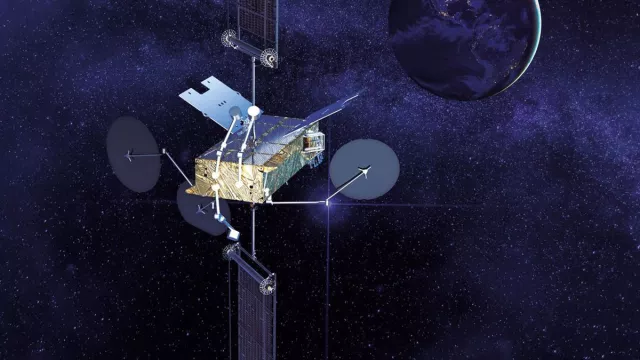Since the mid-2000s, CNES has been developing disruptive technologies and architectures to make legacy geostationary telecommunications satellites operating at microwave frequencies and tailored to individual operators more flexible, generic and competitive—via digitization, active antennas, digital beamforming, microwave systems, mechanically pumped loops (MPL), new highly integrated avionics and electric thrusters—through a succession of R&D projects (FLIP, FAST, GEICO and NEOSAT).
Key information
| Mission | Broadcasting and telecommunications services, ultra-flexible geostationary satellite product line |
|---|---|
| Domain | Telecoms, navigation |
| Launch date | First launch 2026 |
| Partners | Thales Alenia Space, Liebherr Aerospace, SAFT, Coredux, Hemeria |
| Where | Geostationary orbit |
| Lifetime | 15 years |
| Status | In development |
Key figures
- 3 to 4 tonnes: satellite dry mass
- 20-kW satellite class
- 18 new systems and subsystems from CNES R&D
- 10+ French suppliers on satellite
Key milestones
- 2026: First scheduled launch of application programme employing Space Inspire product line
- 2020: Prime Minister gives go-ahead to include Space Inspire in space strand of the France 2030 plan
- 2019: CNES proposes Space Inspire’s inclusion in space strand of the France 2030 plan
- 2018: CNES plays active role alongside Thales Alenia Space in development of Space Inspire
Project in brief
In recent years, the geostationary telecommunications satellite market has become more uncertain, with the emergence of constellations and declining revenues from audiovisual services and data. In response, most operators are now turning to new and cheaper geostationary satellite solutions that are more versatile and optimizing lead times based on a new and standardized FlexSat concept.
Three major telecommunications market players are moving into this FlexSat niche:
- Thales Alenia Space with its Space Inspire satellites, built around a mainly French spacecraft bus and payload
- Airbus Defence & Space with its OneSat satellites, built around a European spacecraft bus and a mainly UK payload
- Boeing with its 702X series derived from the O3b mPOWER satellite
Thales Alenia Space and Airbus Defence & Space have so far won all contracts on offer, selling 13 satellites in total (six for TAS and seven for ADS). CNES has played an active role since 2018 working alongside Thales Alenia Space to establish the new Space Inspire satellite product line.
This product line features numerous innovations and disruptive technologies on both the payload and bus, continuing CNES’s investments in this field over the last 15 years. Following a phase A and phase B funded through the agency’s medium-term plan, a system C/D phase was given the go-ahead by the Secretariat General for Investment (SGPI) under the government’s PIA future investment programme, with CNES as operator.
CNES’s role
CNES is involved in Space Inspire as part of an integrated project team with Thales Alenia Space, providing expertise and guidance, and steering public investment in this product line. It is also working closely with the French industry supplier base (Liebherr Aerospace making its entry into space, SAFT, ArianeGroup, Coredux, Hemeria, etc.).
Contacts
Project Leader
Luca Cerri
E-mail: luca.cerri at cnes.fr
Head of Telecoms & Navigation
Jean-Philippe Taisant
E-mail: jean-philippe.taisant at cnes.fr


